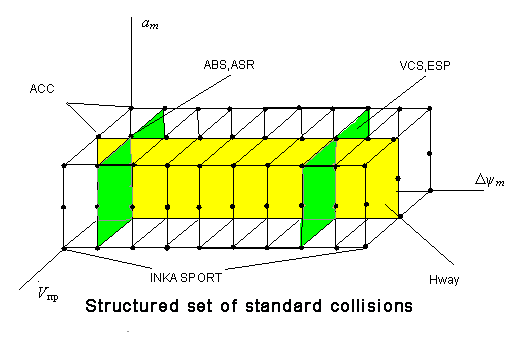

 Russian
Navigation
Russian
Navigation







Computer Active Safety System INKA-SPORT
The Computer Active Safety System INKA-SPORT, developed in Russia, makes it possible to reveal driving errors and dangerous car malfunctions, which can lead to collisions with obstacles.
The operating principle of the system INKA-SPORT is based on the solution in real time of the dynamic stabilization problem for car state coordinates, to which the problem of averting the collisions is reduced in its most general algorithmically resolvable setting.
The dynamic boundaries of the state coordinates are determined from the second-order conditions of averting the standard collisions, and the eigenvalues of the state coordinates are determined by indirect measurements with the use of original mathematical models and the algorithms of incorrect problems solution.

The general view of INKA-SPORT block on dashboard of a car
What gives the Active Safety System INKA-SPORT to contemporary motorist?
|
№ |
Boundaries of safety driving |
Automobile is NOT equipped with the system INKA-SPORT |
Automobile is equipped with the system INKA- SPORT |
|
1 |
Safe distance |
We hope |
We accurately know |
|
2 |
Safe speed |
We hope |
We accurately know |
|
3 |
Tires pressure |
We feel |
We accurately know |
|
4 |
Wheels alignment angles |
Then we will check up |
We accurately know |
|
5 |
Wears of tires cords |
We hope for the best |
We accurately know |
|
6 |
Wheels breakaway |
We don't know |
We accurately know |
|
7 |
Real engine power |
We believe to the advertisement |
We accurately know |
|
8 |
Fuel consumption |
We assume |
We accurately know |
|
9 |
We fall asleep at the steering wheel |
We chew seeds |
It does not give to fall asleep |
|
|
Total: |
We entrust to the fate |
We accurately know that we do |
The timely detection of the dangerous states makes it possible to form controlling influences, which prevent the appearance of the dangerous states and make it possible to prevent the possibility of collision with obstacles.
The composition of technical equipment INKA-SPORT includes four sensors of induction type, which are established on the rims of wheels and the brake backplates, communication cable and the block of information processing, which contains single-crystal computer, liquid-crystal display (LCD) with the multimode keys for control.
Technical characteristics of the system INKA-SPORT::
1. Total number of measurable variables - 64.
2. Total number of computable dynamic boundaries - 23.
3. Quantity of sensors for primary information - 4.
4. Relative error in terms of the variables,% - (0.1 ÷ 5).
5. Speed range, km/h - (4 ÷ 410).
6. Total mass of technical equipment, kg - not more than 0.5.
The Active Safety System INKA-SPORT in the base configuration is intended for operation on the cars of foreign and Russian production without limitations along the models and the year of release. The installation of the Active Safety System INKA-SPORT to a car does not require the introduction of changes in the construction of its aggregates.
Road safety and Active Safety Systems
The problem of road safety is one of the sharpest global problems and affects the vital interests of practically all members of contemporary society.
Attempts at the solution of this problem via incantations, calls to the consciousness and of strengthening repressions are not accompanied by noticeable positive changes in the statistics of road accidents.
The problem of road safety is reduced actually to the solution of two problems:
· averting the collisions of a car with obstacles;
· reduction in the consequences of collisions when could not avoid them.
The analysis of the conditions for potentially possible collisions makes it possible to build the
structured set of standard collisions with fixed, following and oncoming obstacles
(Vob)
at the motion with constant speed, the braking and the accelerations
(аm) under the conditions for unpredictable changes in the direction of motion
(
 )
because of the specific technical malfunctions and driving errors.
)
because of the specific technical malfunctions and driving errors.

The building of highways (Hway) potentially makes it possible to avoid 40 collisions of 100 due to the exception of collisions with fixed and oncoming obstacles. But this requires enormous expenditures and is limited in the cities by historically prevailing infrastructure.
The creation different Active Safety Systems is one of the promising trends of road safety problem solution, developed by the leading foreign automotive firms.
The modern Active Safety Systems (Adaptive Cruise Control, Distronic System, Antilock Brake System, Antispin Regulation, Electronic Stability Program, Vehicle Control System) potentially can prevent only 23 standard collisions of 100.
The creation full-function Active Safety Systems according to traditional diagrams is limited from one side to the absence of the necessary sensors of primary information and to a noticeable increase in the cost of utilized technical equipment, and with another is limited by the high scientific level of problems complexity, insurmountable for the leading foreign firms.
The car equipment of the full-function Active Safety System is equivalent to the constant presence of experienced instructor, who in proper time warns about the approximation to car dangerous states under the changing conditions for the motion.